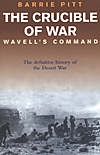 Cassell, 2001, $19.95, ISBN 0-304-35950-5, 332 pages, trade paperback
Cassell, 2001, $19.95, ISBN 0-304-35950-5, 332 pages, trade paperback
The first of three volumes on the WWII North African campaign is a reprint from 1980 and provides a detailed examination of the initial phase of the Desert War, from opening hostilities to the departure of General Sir Archibald Wavell. It is decidedly pro-British, written as it is by a veteran of the war, and laced with the occasional British wit. Yet once you accept the slant, you'll find an absolutely first-class retelling of events punctuated with strategic insight, tactical analysis, and marvelous anecdotes.
The opening moves by the Italians are well told, with plots of their tentative advance and hunkering down in fortified posts. However, well that might have worked against Libyan tribesmen, it didn't work against motorized British forces. From the initial probes of the 11th Hussars with their armored cars, to the attacks upon each fort, you understand the interaction of the various arms--infantry, artillery, armor, navy, and air.
Operation Compass is an eye-opener that saw General O'Connor sweep from the frontier to Tobruk, Benghazi, and the edge of Cyrenaica--with a good chance of reaching Tripoli. With the value of hindsight, Pitt makes you gnash your teeth at the news of troop withdrawals to Greece. Here is one of the great what-ifs of history. Had Britain not sent troops to Greece--and these were the most experienced troops under O'Connor--and instead re-enforced success with reserves, it is quite possible that the British would have tossed the Italians out of North Africa, and certainly out of Tripoli and its port, before the arrival of Rommel and the DAK. Maybe, maybe not. Perhaps Rommel would have ended up in Russia and been called "The Steppe Fox" or some other nickname.
Of some concern is the condescending way in which Pitt treats the Italians, and especially lambastes Italian officers. On the one hand, the British bagged over 100,000 Italian prisoners in a month and a half. On the other hand, it is hard to believe the Italian military was as inept as portrayed. Certainly it was no glorious feat of arms, but if you contrast the almost glowing portrayal of the Italian attack at Beta Fomm with the plethora of surrenders without a shot, there seems to be a disconnect.
In any case, the volume also covers the successful Italian offensive against British Somalia as well as the even more successful British counter-offensive that conquered Italian East Africa. It's a good, succinct chapter with the right balance of detail and brevity.
The turning point in British fortunes comes with the arrival of Rommel and the DAK. Here, the situation reverses, with the British acting like the Italians, and the Germans storming eastward across Cyrenaica. The British are treated more sympathetically, of course.
The last part of the book quickly deals with a pair of British operations: Operation Exporter (the conquest of Palestine area) and Operation Battleaxe (the counterattack against Rommel). The former is successful, the latter a dismal failure.
It is to Cassell's credit that it reissues the book and trilogy (distributed by Sterling Publishing). Pitt has written an eminently readable account, managing to weave in anecdotes, letters, and entries effortlessly and without interrupting the narrative flow. Not only do I recommend this first volume, I look forward to reading the other two.
More Crucible of War
Back to List of Book Reviews: World War II
Back to Master List of Book Reviews
Back to Master Magazine List
© Copyright 2002 by Coalition Web, Inc.
This article appears in MagWeb (Magazine Web) on the Internet World Wide Web.
Other military history articles and gaming articles are available at http://www.magweb.com